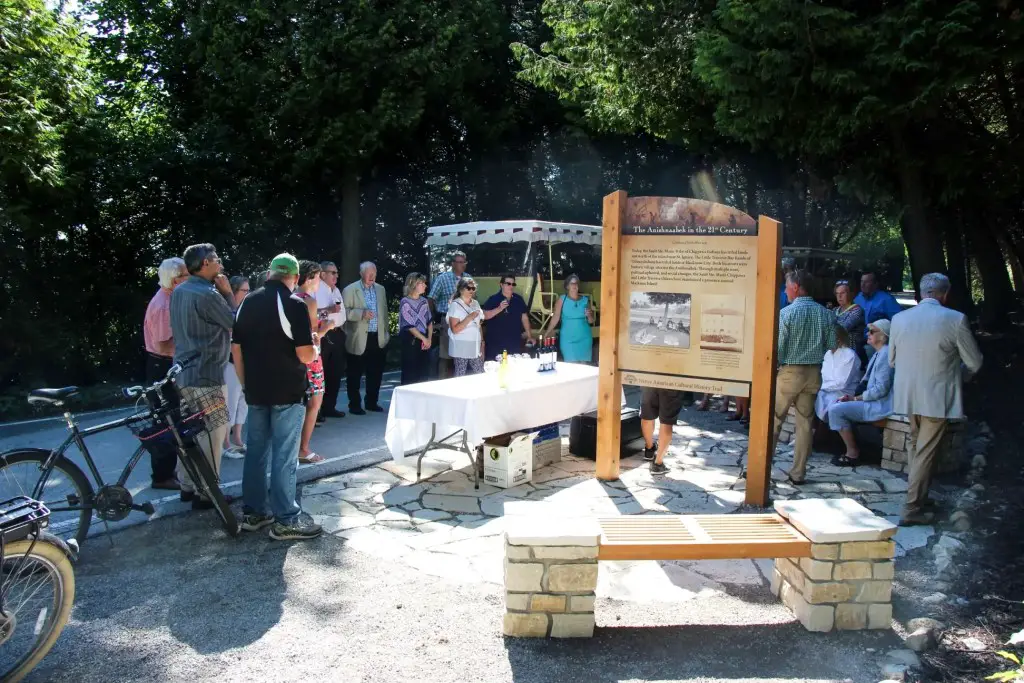Editors Note: From time to time, we highlight neat things to see and do around Michigan. Our family had spent extended time on Mackinac Island when we sailed up Lake Huron’s eastern shore. Bicycling around Mackinac Island is a must-do and is a perfect activity to burn off a big breakfast and see more of the island.
The Michigan Department of Natural Resources released the following article in 2017. It highlights work to bring more information about the Ottawa and Ojibwa tribes’ history and culture on the island. Watch Thumbwind for a future story on how an even more ancient tribe than the Anishnaabee settled the many islands on Lake Huron’s northern shores.
Native American cultural trail deepens historical perspective on Mackinac Island

With hundreds of thousands of visitors every year, Mackinac Island has long been one of Michigan’s favorite vacation destinations.
The island is known for its scenic views – often seen from a bicycle – historical attractions, fudge, and horses. Until recently, many visitors did not know about its connection to Native American history and culture.
“Mackinac Island has a long and rich Native American story that begins centuries before European exploration and continues through today, but this story and its impact on Mackinac history were not effectively communicated to island visitors,” said Phil Porter, director of Mackinac State Historic Parks, the agency that oversees Mackinac Island, State Park.
6 Interpretive Stations To Learn About The Anishnaabek Tribes

In partnership with the Little Traverse Bay Band of Odawa Indians, the Mackinac Island State Park Commission came up with the idea to share this rich history through a series of interpretive stations on Lakeshore Boulevard (M-185), the road around the perimeter of Mackinac Island.
“This location is ideal, as it provides a picturesque and appropriate setting between the waters of Lake Huron and the woods of Mackinac and is used by hundreds of thousands of island visitors every summer,” Porter said.
Mackinac Associates – a friends group that helps preserve and share Straits of Mackinac-area heritage by supporting Mackinac State Historic Parks programs – began fundraising soon after the interpretive trail was proposed.
“One of our major areas of emphasis is education, and assisting residents and visitors better understand the historical value of Native American activity in the upper Great Lakes and around the country fits in with that mission,” said Peter Pellerito, president of Mackinac Associates. “Or board was very supportive of this proposal when it was brought to them. It’s an eminently desirable thing to support.”
Raising Money to Raise Awareness of Tribal Influence on the Island
Many others agreed and jumped on board to back the project and Mackinac Associates exceeding its fundraising goal.

Pellerito said that contributions came from around Michigan and elsewhere, which is emblematic of the widespread interest in the Native American perspective and impact on the Straits area.
“You don’t have to be from Mackinaw City to understand and appreciate the Native American contribution to our part of the world and beyond.”
Eric Hemenway, director of Archives and Records for the Little Traverse Bay Band of Odawa Indians, drafted the language for the interpretive panels, installed in summer 2016, along what is now called the Native American Cultural History Trail.
“The working relationship between Little Traverse Bay Band Odawa Archives and Mackinac State Historic Parks has spanned nearly a decade,” Hemenway said. “We have worked together on numerous other projects centered around telling the diverse story of the Straits of Mackinac.
The work always was one of mutual respect and wanting to give the visitor to the Straits area the best possible experience. Part of enhancing that experience realized that Mackinac Island could use more interpretation of the Anishnaabek (Odawa, Ojibway, and Potawatomi) story to the island.”
6 Interceptive Points Around the Island

Out of that collaboration between the two organizations came six signs telling different stories of Native Americans at the Straits of Mackinac. The six themes the interpretive panels cover include:
- Cultural significance: Mackinac Island has an important place in the history of the Anishnaabek, going back thousands of years and well documented in text and oral traditions.
- Resting place of the ancestors: The islands of the Great Lakes have long been deemed sacred, not only for the spirits who live on them but also because they serve as sacred burial grounds. Mackinac Island, Round Island, and Bois Blanc Island are all burial areas for ancient Anishnaabek.
- People of the water: The Anishnaabek were, and are to this day, a people of the water, fishing the Great Lakes as well as traveling hundreds of miles to carry out trade and wage war. Mackinac Island, in the center of the upper Great Lakes, has been a summer gathering place for the Anishnaabek for centuries.
- Contest for the island: French, British, Americans, and various tribes would all fight to control the Straits of Mackinac and Mackinac Island. Mackinac Island had an important role in the Iroquois War, French and Indian War, Pontiac’s War, and War of 1812. On some of these occasions, the Anishnaabek fought to keep their island.
- The Treaty of 1836: This treaty marked a pivotal moment for the Odawa and Ojibway of northern Michigan, helping to shape not only their history but that of Michigan and the United States as well.
- The Anishnaabek in the 21st Century: The Odawa and Ojibway avoided removal during the 19th century and fought for their rights throughout the 20th century.
The six interpretive panels were placed at stopping points along Lake Huron and incorporated into resting stations with benches and bicycle parking.
“Biking around the perimeter of the island is a popular activity, but with three-quarters of a million people or more coming to the island every year, it can get congested when visitors stop to take photos or admire the scenery,” said Porter. “Hopefully, the convenience of these bike parking areas will decrease some of that congestion while simultaneously offering an important educational experience.”
Ideal Rest Stops Around Mackinac Island

The interpretive panels and areas surrounding them were designed to blend with the natural surroundings, utilizing locally familiar products like cedar and limestone so as not to be obtrusive to the island’s natural beauty.
Mackinac State Historic Parks’ staff constructed the stations and designed, produced and installed the interpretive panels.
“I feel very honored to have been able to design a site like this that interprets such important and often under-represented information in such a holistic way,” said Mackinac State Historic Parks exhibit designer Keeney Swearer. “So often when creating trailside panels, there is only room to talk about a few subjects that often don’t give readers the larger context to the story.
Since we had so much room, we were able to spread the information out and deliver it to the visitors in a more deliberate way, hopefully introducing them to some of these larger concepts.”
Swearer added that the large panels also allowed the development team to present a wide variety of images, from early sketches and prints to modern photographs, most of which had not been used at Mackinac State Historic Parks before.
In addition to Mackinac Island Historic State Park, its sites include Colonial Michilimackinac, Fort Mackinac, Historic Mill Creek Discovery Park, Old Mackinac Point Lighthouse, and The Richard and Jane Manoogian Mackinac Art Museum.
Learn more at www.mackinacparks.com. All images were provided as a courtesy of the Michigan Department of Natural Resources.




